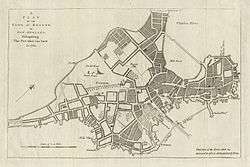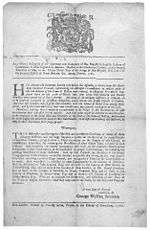Great Boston fire of 1760

The Great Boston fire of 1760 was a major conflagration that occurred on March 20, 1760, in downtown Boston. The fire destroyed 349 buildings in the area between the modern Washington Street and Fort Hill as well as several ships in port, and left over a thousand people homeless.
Background
Since its inception in 1630, the town of Boston was repeatedly damaged by fire, with serious conflagrations taking place in 1653, 1676, 1679, 1682, 1691, 1711, and 1753.[1] Prior to 1760 the term "Great Fire" had been reserved for the fire of 1711, which had destroyed the First Town-House, but the 1760 blaze proved to be significantly larger and rendered the 1711 one as "comparatively unimportant."[2]
During the month of March 1760, Boston suffered from a series of large fires. On March 17 a blaze damaged several buildings in the West End, including the wooden meeting house which stood on the current site of the Old West Church. On the following day a fire broke out in a building occupied by the Royal Artillery on Griffin's Wharf and soon spread to a quantity of gunpowder and weapons, causing an explosion that destroyed the building and wounded four or five men.[3]
The Great Fire

At about 2:00 a.m. on March 20, a fire of unknown cause broke out at a dwelling in Cornhill (modern Washington Street, nearly opposite to Pie Alley). Although the blaze was prevented from spreading much to the north or south, it aggressively made its way to the east to Oliver's Dock on the harbor, destroying most of the structures in its path. A veer in the wind caused the fire to change direction toward King (now State) Street, burning the homes on the corner opposite the Bunch-of-Grapes tavern and damaging the warehouses toward the Long Wharf.
On its southeastern side, the fire expanded from Water Street to Milk Street, where it consumed many of the houses to both the west and east. From there it advanced via Batterymarch to Fort Hill, taking most of the buildings along the way, and reached the South Battery. A panic soon arose over the presence of a large deposit of gunpowder near the battery, but most of the store was hurriedly removed just before the fire reached the area. The remaining powder was ignited by the blaze, however, causing a huge explosion which was heard from as far away as Hampton, New Hampshire.[4]
Aftermath

The 1760 fire was described by one contemporary writer as "the most terrible Fire that has happened in [Boston]" up to that time, although it would later be eclipsed by the Great Boston Fire of 1872.[5] 174 houses and 175 warehouses, shops and other buildings were destroyed in the blaze, leaving some two hundred and twenty families homeless, and the total estimated losses of £53,334 hit especially hard a town that had already "borne the extraordinary Expence" of the ongoing French and Indian War.[6] The human toll of the conflagration, on the other hand, was relatively light, with none reported dead and only a few wounded.[7]
In the immediate aftermath of the fire, the Massachusetts colonial legislature advanced £3,000 to Boston for relief assistance.[8] Over the following months, the town received several donations from throughout the British Empire as news of the disaster spread. The Assemblies of Pennsylvania and New York voted to send relief funds, while in Nova Scotia a significant amount of money was raised for the town, and individuals from as far away as London sent contributions.[9] A petition for assistance was also sent to either King George II or George III, but what action was taken as a result is unknown.[10]
In order to prevent a similar disaster from occurring in the future, the Massachusetts legislature passed new laws and acts that improved fire safety standards in Boston. Any new building more than seven feet high that was made of wood would result in a fine, and a committee was appointed to re-lay the narrow streets of the burnt district. As a result of the new regulations, the homes that were rebuilt in the area were made of brick or slate instead of wood.[11]
Notes
- ↑ Novak 1996, p. 55.
- ↑ Drake 1856, p. 649; Conwell 1873, p. 33.
- ↑ Drake 1856, p. 649; Brayley 1889, p. 60.
- ↑ Drake 1856, pp. 649–51; Brayley 1889, pp. 60–62.
- ↑ Drake 1856, p. 649; Brayley 1889, pp. 60, 273.
- ↑ Drake 1856, pp. 650–51; Brayley 1889, pp. 61–64. Earlier estimates of the losses were significantly higher, ranging from £100,000 to £300,000. For an analysis of loss claims, see Penack 1979, pp. 267 ff.
- ↑ Drake 1856, p. 652; Brayley 1889, p. 61.
- ↑ Drake 1856, p. 651; Brayley 1889, p. 62.
- ↑ Drake 1856, pp. 651–52; Brayley 1889, pp. 64–65.
- ↑ Drake 1856, p. 652; Brayley 1889, pp. 63–64.
- ↑ Drake 1856, p. 653; Brayley 1889, p. 65.
References
- Brayley, Arthur Wellington (1889). A Complete History of the Boston Fire Department, Including the Fire-Alarm Service and the Protective Department, From 1630 to 1888, Part One. Boston: John P. Dale & Co.
- Conwell, Russell H. (1873). History of the Great Fire in Boston, November 9 and 10, 1872. Boston: B. B. Russell.
- Drake, Samuel G. (1856). The History and Antiquities of Boston, the Capital of Massachusetts and Metropolis of New England, From its Settlement in 1630 to the Year 1770. Boston: Luther Stevens.
- Novak, William J. (1996). The People's Welfare: Law & Regulation in Nineteenth-Century America. Chapel Hill: University of North Carolina Press. ISBN 0-8078-2292-2.
- Penack, William (1979). "The Social Structure of Revolutionary Boston: Evidence from the Great Fire of 1760". The Journal of Interdisciplinary History. 10 (2): 267–278. JSTOR 203337.
Coordinates: 42°21′27″N 71°03′30″W / 42.3575°N 71.0584°W